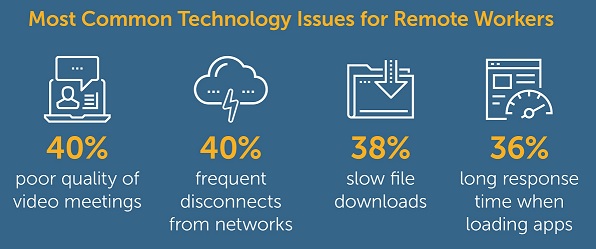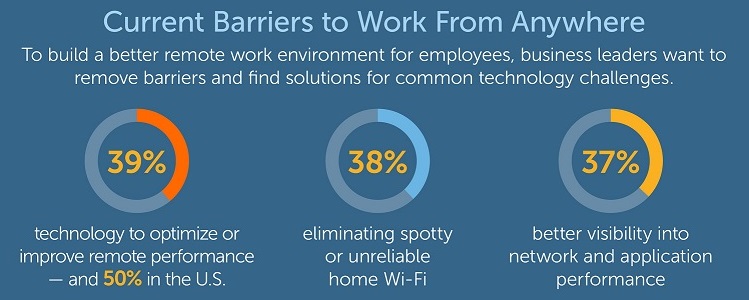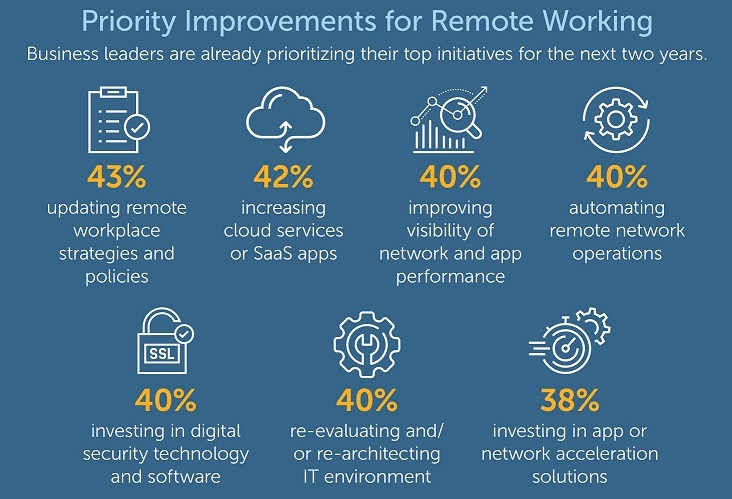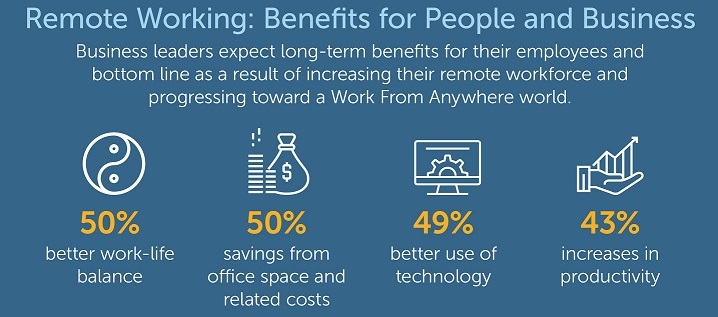Business leaders around the world are comfortable and optimistic about the broad scale shift toward remote work, according to the Riverbed Future of Work Global Survey 2020 that included 700 business decision makers, however findings also indicate the vast majority of organizations were not well prepared when the COVID-19 pandemic began.
Moving forward, the majority of business leaders said they are investing in technology to improve remote work performance and have high expectations of their return.
The survey found that while 95% of business leaders are comfortable with their employees working remote (and 63% completely or very comfortable), from a technology standpoint, 69% of these same business leaders reported they were not completely prepared to support extensive remote work at the beginning of the outbreak.
The healthcare industry, at the center of the crisis, understandably had the most (86%) most respondents that were not completely prepared, followed by manufacturing (72%), retail (69%), professional services (66%), and financial services (58%).
"Businesses had already been accommodating more remote workers the past several years, but COVID-19 is accelerating this, and the office of the future will clearly look very different with a more flexible and hybrid workplace," said Rich McBee, President and CEO of Riverbed. "This new study shows that business leaders are now much more comfortable with their teams working remote, however organizations must have the right technology in place to ensure greater productivity and a better remote experience as employees increasingly work from anywhere."
Performance Issues Impacting Employees and the Business
Nearly all (94%) business leaders surveyed reported technology performance issues for remote workers that have impacted their employees and the business. The most common issues — all resolvable — include:
■ Poor quality of video meetings (40%)
■ Frequent disconnects from corporate networks (40%)
■ Slow file downloads (38%)
■ Long response time when loading apps (36%)

When asked about the impact these issues have on the remote work experience of employees, business leaders report:
■ Increased technical disruptions (40%)
■ Weaker employee performance and lack of productivity (37%)
■ Increased anxiety and stress (36%)
■ A lack of work motivation (34%)
■ Increased difficulty engaging with customers (34%)

Barriers to Success
Business leaders say the biggest barriers to success for ensuring the performance of a remote workforce are:
■ Technology to optimize or improve remote performance (39% globally; and 50% in the US)
■ Spotty or unreliable home Wi-Fi (38%)
■ The need for better visibility into network and application performance (37% globally; and 43% in the US and 42% in France)

Remote and Flexible Workforces Expected to Increase Significantly
Despite challenges, nearly one in five (19%) business leaders globally expect half or more of their employees to work remotely (full time or at least half time) after COVID-19.
Additionally, on average, business leaders globally expect 25% of employees to work remote after COVID-19, a near 50% increase versus prior to the pandemic.
Industries projecting the largest average percentage of their teams to work remote after COVID-19 are those less dependent on physical presence, including financial services (39% vs. 28% before the outbreak) and professional services (35% vs. 28%).
Geographically, US business leaders expect 42% of their employees to work remote after COVID-19 (a 27% increase versus prior to COVID-19), while in Saudi Arabia and UAE the expectation is 28% working remote, also an increase of 27%.
Business Leaders Investing In Technology for Remote Workforce Performance
To drive greater remote working performance, 61% of business leaders plan to make additional technology investments — and 31% plan to make significant investments — in the next 12 months.
In the US, a robust 86% plan to make additional technology investments, while in Saudi Arabia/UAE and the UK, 79% and 72% of business leaders plan to invest, respectively.
Among industries, financial services (84%) and healthcare (79%) plan to make additional investments over the next year.
Business leaders have already begun to identify their priority strategies and technologies to enhance remote work for their employees and their company. The top initiatives business decision makers plan to undertake in the next two years include:
■ Updating company-wide remote workplace strategies and policies (43%)
■ Increasing the use of cloud services or SaaS apps (42%)
■ Using software for better visibility of network and applications performance (40%)
■ Deploying technology to automate remote network operations (40%)
■ Investing in digital security technology and software (40%)
■ Re-evaluating and/or re-architecting IT environment (40%)
■ Investing in application or network acceleration solutions (38%)

Globally, business leaders expect to gain long-term benefits for their employees and bottom line as a result of increasing their remote workforce, including:
■ Better work-life balance 50%
■ Savings from office space and related costs 50%
■ Better use of technology 49%
■ Increases in productivity 43%

Methodology: The Riverbed Future of Work Global Survey 2020 is the result of a custom online survey completed in June 2020 by Wakefield Research with 700 business decision makers at companies with $500M+ in annual revenue from across the United States, United Kingdom, Germany, Australia, and UAE/Saudi Arabia. Quotas were set for 100 respondents within each of the following verticals: Financial Services, Manufacturing, Professional Services, Healthcare and Retail.
